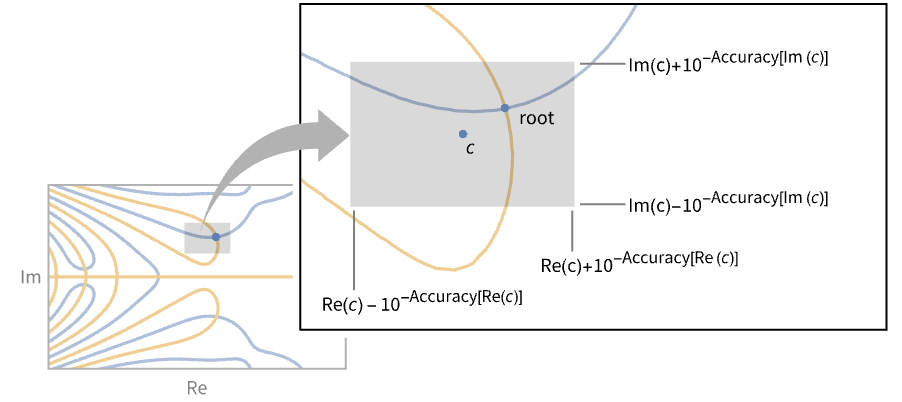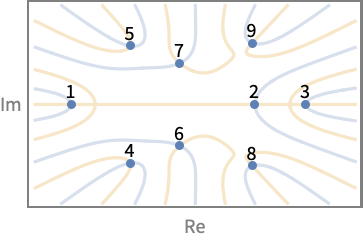Root[{f,c}]
represents the exact root of the general equation f[x]0 near x=c.
Root[{{f1,…,fn},{c1,…,cn}},j]
represents the j![]() coordinate of the exact root of the system of equations {f1[x1,…,xn]0,…,fn[x1,…,xn]0} near {x1,…,xn}={c1,…,cn}.
coordinate of the exact root of the system of equations {f1[x1,…,xn]0,…,fn[x1,…,xn]0} near {x1,…,xn}={c1,…,cn}.
Root[f,k]
represents the exact k![]() root of the polynomial equation f[x]0.
root of the polynomial equation f[x]0.
Root[{f1,f2,…},{k1,k2,…}]
represents the last coordinate of the exact vector {a1,a2,…} such that ai is the ki![]() root of the polynomial equation fi[a1,…,ai-1,x]0.
root of the polynomial equation fi[a1,…,ai-1,x]0.


Root
Root[{f,c}]
represents the exact root of the general equation f[x]0 near x=c.
Root[{{f1,…,fn},{c1,…,cn}},j]
represents the j![]() coordinate of the exact root of the system of equations {f1[x1,…,xn]0,…,fn[x1,…,xn]0} near {x1,…,xn}={c1,…,cn}.
coordinate of the exact root of the system of equations {f1[x1,…,xn]0,…,fn[x1,…,xn]0} near {x1,…,xn}={c1,…,cn}.
Root[f,k]
represents the exact k![]() root of the polynomial equation f[x]0.
root of the polynomial equation f[x]0.
Root[{f1,f2,…},{k1,k2,…}]
represents the last coordinate of the exact vector {a1,a2,…} such that ai is the ki![]() root of the polynomial equation fi[a1,…,ai-1,x]0.
root of the polynomial equation fi[a1,…,ai-1,x]0.
Details and Options




- Root is also known as an algebraic number when f is polynomial with integer coefficients or a transcendental number when there is no such polynomial f possible.
- Root is typically used to represent an exact number and is automatically generated by a variety of algebra, calculus, optimization and geometry functions.
- Root represents an exact number as a solution to an equation f[x]0 with additional information specifying which of the roots is intended.
- Root numbers can be used like any other numbers, both in exact and approximate computations.
- Root numbers are formatted as
 where approx is a numerical approximation. An approximation to precision p can be computed using N[
where approx is a numerical approximation. An approximation to precision p can be computed using N[ ,p].
,p]. - For most uses, Root objects are automatically generated and can be directly used. For advanced uses, when your code is going to directly generate Root objects, a deeper understanding of the different representations is necessary.
- There are two distinct mechanisms used to specify which root of an equation is represented, the neighborhood representation Root[{f,c}] and the indexing representation Root[f,k].
- The root neighborhood representation Root[{f,c}] specifies the equation f[x]0 as well as the neighborhood rectangle centered at c and width
 and height
and height  .
. - The root neighborhood representation for systems Root[{{f1,…,fn},{c1,…,cn}},j] similarly specifies a system of equations {f1[x1,…,xn]0,…,fn[x1,…,xn]0} and a neighborhood given by the product of rectangles from ci for the different coordinates.
- The root neighborhood representation Root[{f,c,m}] specifies that f[x]0 has a root of multiplicity m in the neighborhood given by c. However, it may be a cluster of closely spaced roots and by refining the neighborhood c, i.e. higher precision root approximation, they may separate. »
- The root indexing representation Root[f,k] applies to polynomial functions f only. The indexing of roots takes the real roots first, in increasing order. For polynomials with rational coefficients, the complex conjugate pairs of roots have consecutive indices.
- The root indexing representation for systems Root[{f1,f2,…,fk},{k1,k2,…,kn}] applies to triangular systems of polynomial equations only. Given equations f1[x1]0, f2[x1,x2]0, …, fn[x1,x2,…,xn]0, we recursively define r1 as the k1
 root of f1[x1]0, r2 as the k2
root of f1[x1]0, r2 as the k2 root of f2[r1,x2]0 and finally rn as the kn
root of f2[r1,x2]0 and finally rn as the kn root of fn[r1,…,rn-1,xn]0. The represented root is rn.
root of fn[r1,…,rn-1,xn]0. The represented root is rn.




Examples
open all close allBasic Examples (4)
Scope (22)
Basic Uses (5)
Roots of Univariate Functions (4)
Real roots of an exp-log function:
The Root representation involves a univariate function and an approximation that isolates the root:
The Root object is an exact numeric expression:
Roots of an analytic function in a bounded region:
This representation is used for roots of polynomials of degrees that exceed $MaxRootDegree:
The approximation used to represent the root is equal to ![]() , but the root is not:
, but the root is not:
Roots of Multivariate Systems (1)
Find a solution instance to a system of transcendental equations:
The roots are exact numeric expressions:
The Root representation involves a multivariate system and an approximation that isolates the root:
Roots of Univariate Polynomials (10)
Roots of a univariate polynomial with rational coefficients are algebraic numbers:
The polynomials are automatically reduced:
A minimal polynomial is always irreducible and primitive:
Use MinimalPolynomial to extract the minimal polynomial:
A Root object representing an algebraic number has three arguments:
The third argument is 0 (default value) or 1 and indicates the root isolation method to be used:
The root isolation method used may affect the ordering of non-real roots:
Roots of polynomials of degree at 1 and 2 simplify automatically:
An algebraic combination of algebraic numbers is an algebraic number:
Use RootReduce to represent the result as a single Root object:
The canonicalization is not done automatically since minimal polynomials can grow rapidly:
Complex components of algebraic numbers:
Root of a polynomial with exact numeric coefficients is an exact numeric object:
Roots of a polynomial with coefficients involving symbolic parameters:
Find the series with respect to the parameter:
Find Puiseux series of a root at a branch point:
Roots of a quadratic with symbolic coefficients:
When a, b, c and the roots are real, the roots are always ordered by their values:
The "standard" formulas for the roots of a quadratic do not guarantee the ordering of roots:
Roots of Triangular Polynomial Systems (2)
Real root of a triangular system of equations:
The Root representation involves a triangular polynomial system and root indices:
The Root object is an exact numeric expression:
Roots of systems of polynomials with rational coefficients have algebraic number coordinates:
The degree of the minimal polynomial is generally the product of degrees of the system polynomials:
This representation is used for roots of polynomials with algebraic number coefficients:
Convert the root to the canonical algebraic number representation:
Options (1)
ExactRootIsolation (1)
Root[f,k] by default isolates the complex roots of a polynomial using validated numerical methods. Setting ExactRootIsolationTrue will make Root use symbolic methods that are usually much slower.
The setting of ExactRootIsolation is reflected in the third argument of a Root object:
Root isolation is performed the first time the numerical value of the root is needed:
The symbolic complex root isolation method is usually slower than the validated numeric one:
The root isolation method may affect the ordering of nonreal roots:
Applications (19)
Solve polynomial equations of any degree in closed form in terms of Root:
Solve the characteristic equation of a Hilbert matrix:
Using Eigenvalues:
Find the minimum of a parameterized polynomial:
Solve a constant coefficient differential equation of any degree:
Solve a constant coefficient difference equation of any degree:
Find a solution of a triangular system of equations:
Represent the solution in the Root[f,k] form:
Here, the Root[f,k] representation would involve a polynomial of degree 1000000:
Compute an approximate value of the solution:
Solve univariate exp-log equations and inequalities over the reals:
Solve univariate elementary function equations over bounded intervals and regions:
Solve univariate analytic equations over bounded intervals and regions:
Find real roots of high-degree sparse polynomials and algebraic functions:
Solve univariate transcendental optimization problems:
Integrate a piecewise function with an exp-log inequality condition:
Evaluate the hard hexagon entropy constant:
Compute the Laplace limit constant:
Plot a root as a function of a parameter:
Solve a convex optimization problem:
Find a solution instance of a system of transcendental equations and inequalities:
Properties & Relations (11)
Root objects represent exact numbers:
Compute approximations to arbitrary precision:
Use MinimalPolynomial to find minimal polynomials of algebraic numbers:
Use ToRadicals to attempt to convert a Root object to an arithmetic combination of radicals:
All roots of polynomials of degree not exceeding 4 are representable in radicals:
Use RootReduce to canonicalize algebraic numbers, including from operations:
Use AlgebraicNumber for computations within a fixed simple extension of the rationals:
Rational operations on AlgebraicNumber objects produce AlgebraicNumber objects:
Use ToNumberField to express given algebraic numbers as elements of the same simple extension:
Perform computations within the common simple extension or rationals:
RootSum represents the sum of values of a function over roots of a polynomial:
Use Normal to represent the sum using explicit roots:
For rational functions, the sum can be computed without finding the roots:
Simplify combinations of Root objects:
Solve an equation for a parameter in a Root object:
Use ImplicitD to compute derivatives of implicit solutions of equations:
Compare with the result obtained by computing the derivative of ![]() directly:
directly:
Compute series expansions of implicit solutions to equations:
Use AsymptoticSolve to find series expansions of all roots:
Use RootApproximant to generate Root objects that approximate given numbers:
Possible Issues (5)
Series at branch points may not be valid in all directions:
Canonicalization is only possible for parameter‐free roots:
Parameterized roots can have complicated branch cuts in the complex parameter plane:
A non-polynomial Root object may represent a cluster of distinct roots:
Numerical computation with a higher precision yields an approximation of one of the roots:

The choice of root stays the same for subsequent computations:
A larger setting for $MaxExtraPrecision can be needed for roots with noninteger coefficients:

Tech Notes
Related Guides
Related Links
History
Introduced in 1996 (3.0) | Updated in 2007 (6.0) ▪ 2008 (7.0) ▪ 2012 (9.0) ▪ 2019 (12.0) ▪ 2021 (12.3)
Text
Wolfram Research (1996), Root, Wolfram Language function, https://reference.wolfram.com/language/ref/Root.html (updated 2021).
CMS
Wolfram Language. 1996. "Root." Wolfram Language & System Documentation Center. Wolfram Research. Last Modified 2021. https://reference.wolfram.com/language/ref/Root.html.
APA
Wolfram Language. (1996). Root. Wolfram Language & System Documentation Center. Retrieved from https://reference.wolfram.com/language/ref/Root.html
BibTeX
@misc{reference.wolfram_2025_root, author="Wolfram Research", title="{Root}", year="2021", howpublished="\url{https://reference.wolfram.com/language/ref/Root.html}", note=[Accessed: 22-January-2026]}
BibLaTeX
@online{reference.wolfram_2025_root, organization={Wolfram Research}, title={Root}, year={2021}, url={https://reference.wolfram.com/language/ref/Root.html}, note=[Accessed: 22-January-2026]}